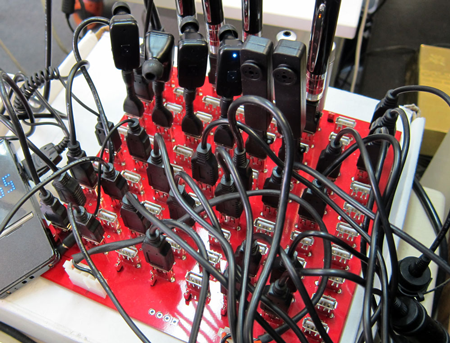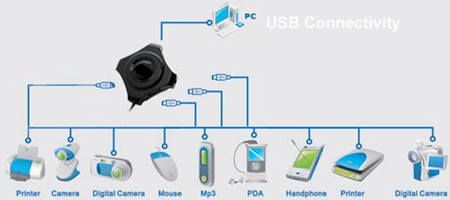Does The USB 3.0 Controller On Your Motherboard Matter?
Is There A Difference Between USB 3.0 Configurations?
There are several USB 3.0 controllers on the market. But which is the best? This isn't really something you can determine by transferring a few files to one external device. Rather, you want to go as far as possible to saturate the bus.
USB connectivity is so ubiquitous that many of us are accustomed to running systems with nearly every port populated. This can have a significant impact on performance. For example, the maximum data rate for USB 2.0 is 480 Mb/s, but that’s per controller and is divided amongst all attached devices. Once upon a time, a single USB device couldn't consume all of that bandwidth. Scaling up to two or three, however, certainly could hit the ceiling. Today, it's not difficult at all to butt up against the limits of USB 2.0 with just one external hard drive.
One way to overcome the bottlenecks imposed by sharing bandwidth is to employ multiple controllers. That’s the idea behind HighPoint’s RocketU 1144A add-in card. The board maps each of its four USB 3.0 ports to a single ASMedia ASM1042 controller, leveraging an eight-lane PEX8609 switch to deliver 2 GB/s of bandwidth in each direction over a PCI Express x4 slot. That's balanced perfectly to the 500 MB/s In theory, that should provide 500 MB/s of dedicated bandwidth per port, which syncs up well with the 500 MB/s theoretical limit of USB 3.0 (5 Gb/s divided by eight bits per byte, time .8 to account for 8b/10b encoding).
Compare that implementation to what you see built onto motherboards. Gigabyte’s A75-UD4H and Asus’ F1A75-V Pro both facilitate four USB 3.0 ports through the A75 Fusion Controller Hub (FCH). Additional connectivity is provided via the EJ168 (Gigabyte) and ASM1042 (Asus) controllers.
More specifically, the A75-UD4H relies on two EJ168 controllers to support four additional USB 3.0 ports, while Asus employs a single ASM1042 that provides support for two extra ports. However, these third-party solutions are technically less than ideal because two ports need to share the bandwidth provided by a single PCIe x1 lane. In a situation where you have two high-speed devices attached to the same controller, you'd theoretically be bottlenecked.
Regardless, we’re out to answer two questions:
- Is there one USB 3.0 controller that's better than the others?
- Do bottlenecks exist when you plug multiple performance-oriented devices into one controller?
To that end, we’re testing the storage performance of various USB 3.0 controllers under the following configurations:
Get Tom's Hardware's best news and in-depth reviews, straight to your inbox.
HighPoint RocketU 1144A and AMD A75 FCH:
- One USB 3.0 device
- Two USB 3.0 devices
- Four USB 3.0 devices
Etron EJ168 and ASMedia ASM1042:
- One USB 3.0 device
- Two USB 3.0 devices
Current page: Is There A Difference Between USB 3.0 Configurations?
Prev Page The Controller Lineup Next Page Test Setup And Benchmarks-
amk-aka-Phantom Asus changed the USB 3.0 controller on their P8P67 line of boards... I think they switched to ASMedia from NEC, and I'd love to see the difference between the two benchmarked. I think this article has way too few controllers; there're more USB 3.0 solutions on the market.Reply
Well, at least the article showed that it's possible to reach 150 MBps write speeds and higher... good enough for me. Now all I need is a USB 3.0 drive :) -
The Greater Good That's why eSATA is the best for external storage. USB is great for everything other than data throughput.Reply -
de5_Roy thanks for the article! i always use usb drives, most of the old drives using usb converters. good to know i can run multiple of them without hitting speed limit.Reply -
lockhrt999 They should have included windows 8 in this benchmark. On my system win7 writes at 3-4 MB/s to thumb drive and win8 writes at constant 10 MB/s to same thumb drive. (Everything's USB 2.0 though). Some witchcraft :D I don't know but they should have included win 8.Reply -
lp231 The Greater GoodThat's why eSATA is the best for external storage. USB is great for everything other than data throughput.Reply
I've tried eSATA and found out it's not as user friendly as USB.
You will need a external power source if the eSATA isn't self powered.
Then you will also have to setup the right bios config or the eSATA won't
work properly like it's suppose to and basically the eSATA drive becomes a internal cause you lose the ability of hot plugging and swapping. -
lockhrt999 lp231I've tried eSATA and found out it's not as user friendly as USB. You will need a external power source if the eSATA isn't self powered.Then you will also have to setup the right bios config or the eSATA won'twork properly like it's suppose to and basically the eSATA drive becomes a internal cause you lose the ability of hot plugging and swapping.Reply
What? Even internal drives can be hot plugged and swapped. OS recognizes both internal and external sata drives alike. Once you connect it just go into My computer > manage > devices and search for new drives. To unplug simply right click on that drive and click disable. Even this can be done with IDE (ATA) provided you don't use old P4 era motherboards. -
Crashman lockhrt999What? Even internal drives can be hot plugged and swapped. OS recognizes both internal and external sata drives alike. Once you connect it just go into My computer > manage > devices and search for new drives. To unplug simply right click on that drive and click disable. Even this can be done with IDE (ATA) provided you don't use old P4 era motherboards.You started off right but then went soooo wrong.Reply
1.) Motherboards with hot-plug capability to internal drives were available almost from the beginning. Nvidia was famous for adding this function to its drive controller firmware, and ASRock was famous for adding it to the drive controller firmware of boards with other chipsets.
2.) To this very day, the ports of many NEW motherboards STILL lack firmware support for this function on at least some of the ports. A few lack hot swap firmware on all of the ports, and a many have this feature selectable in BIOS.
So, even though you're part right, the person you responded to is more right. -
lockhrt999 CrashmanYou started off right but then went soooo wrong.1.) Motherboards with hot-plug capability to internal drives were available almost from the beginning. Nvidia was famous for adding this function to its drive controller firmware, and ASRock was famous for adding it to the drive controller firmware of boards with other chipsets.2.) To this very day, the ports of many NEW motherboards STILL lack firmware support for this function on at least some of the ports. A few lack hot swap firmware on all of the ports, and a many have this feature selectable in BIOS.So, even though you're part right, the person you responded to is more right.Reply
Thanks for filling me. Coincidentally I never came across motherboard that doesn't support hot plugging out of the box that's why I thought everyone supports it. -
I am a little surprised to see no mention made of USB 3 connections being dropped when plugging a (supposedly) USB 3-capable external dock or enclosure into a motherboard port connected to a Renesas/NEC USB 3 controller. Speculation faults, for instance, the JMicron USB 3 controller on the dock/enclosure; ASMedia is speculated to be less problematic. At any rate, "real world" experience finds dropped connection problems, which makes speed a secondary concern. Can this "dropped USB 3 connection" issue be addressed as well? Thanks.Reply


